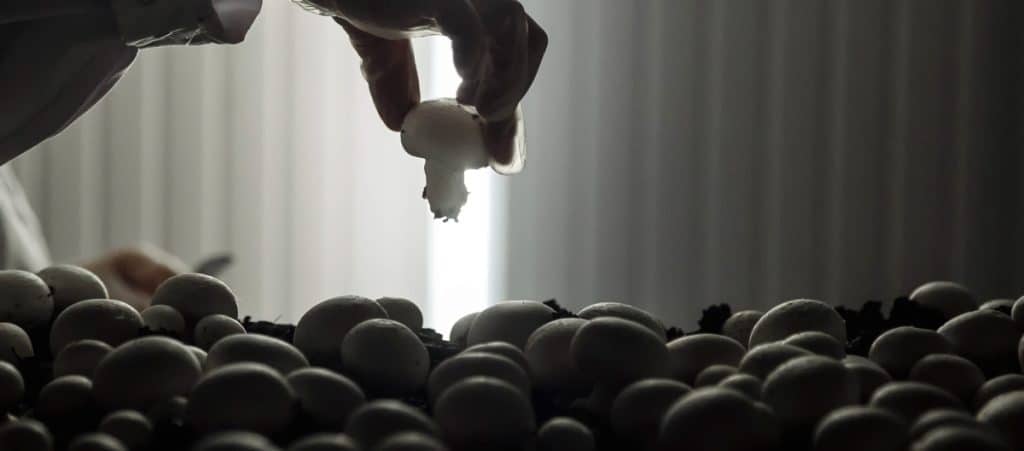Fungi and their fruiting bodies, which we call mushrooms, are the focus of several studies as they can potentially solve some of the world’s food production problems.
Increasingly popular, gourmet mushrooms are full of beneficial bioactive compounds and a good source of protein, vitamins and dietary fiber.
But it’s not only mushrooms that are proving valuable. Innovators have produced several products using mushroom mycelium. Everything from meat replacements, building materials and textiles to biodegradable coffins.
But are fungi sustainable?
The answer is yes.
Fungi are amazing organisms with numerous environmentally-friendly applications, and we’re just beginning to discover their potential.
Read on to learn more about fungi and mushrooms and why growing mushrooms is sustainable and can help feed future generations.
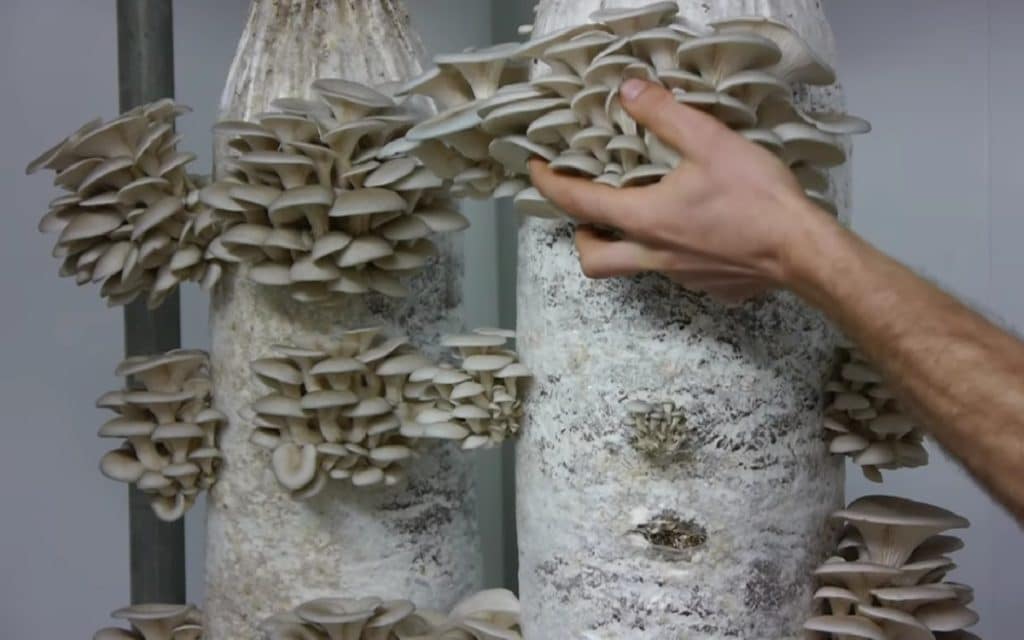
What Are Mushrooms?
Mushrooms are the fruiting bodies (fruit) of a fungus that’s often hidden from sight underground or inside dead and decaying stumps and logs.
Fungi are neither plants nor animals, although we tend to think of them as vegetables, and you’ll often find them in the vegetable section of grocery stores.
Fungi cannot produce their own food like plants, and like us have to get the nutrients they require from the environment around them. But they digest their food externally.
When categorized based on how they get their food, there are 4 classifications: saprotrophs, mycorrhizae, parasites and endophytes.
Fungi are complex organisms and often fit into more than one of these groups or get moved from one group to the next as scientists learn more about them.
Most of the fungi that produce edible gourmet mushrooms are saprotrophs that get the nutrients they need to grow from dead and decaying organic matter. They play a crucial role in ecosystems as primary and secondary decomposers.
As fungi digest or decompose the organic matter around them, creating small particles they can absorb, they make nutrients available for other organisms and improve the soil.
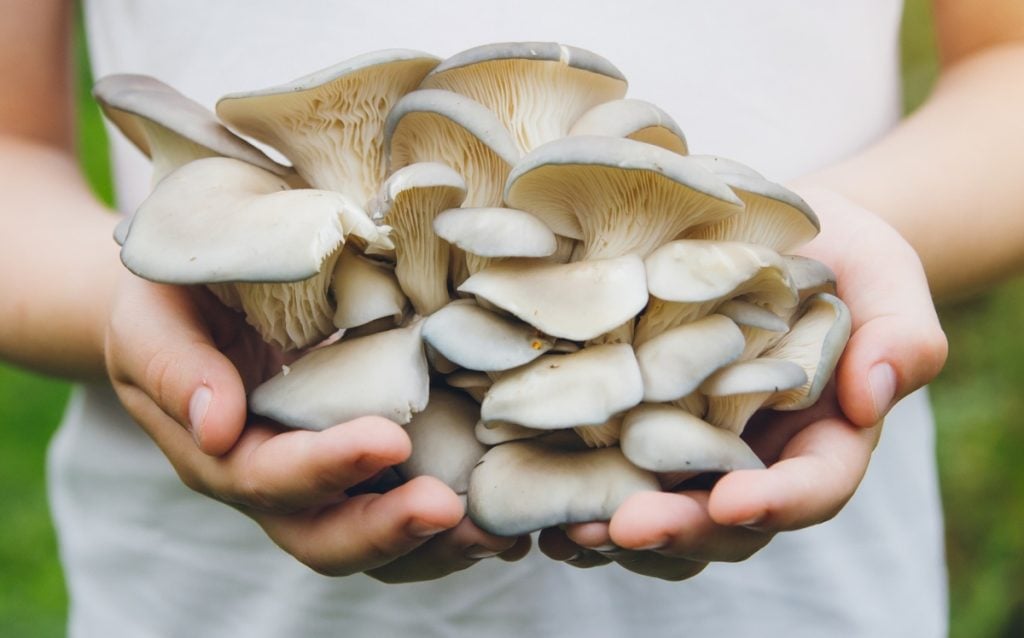
What Makes Mushrooms Sustainable Crops?
Mushrooms are an excellent crop for a farmer, urban or rural, and numerous factors contribute towards making them both lucrative and sustainable.
In 2017 the mushrooms council commissioned a sustainability study using 30 of the biggest mushroom farms in the united states.
These farms primarily focussed on producing Agaricus bisporus, the common button, cremini or portobello mushrooms you find in grocery stores worldwide.
The study confirmed that mushrooms need less water, energy and space to grow than many other crops. But a few other factors also contribute to them being profitable, sustainable crops for farms of all sizes.
8 Reasons Mushroom Growing is Sustainable
Many people who are considering growing mushrooms wonder if mushroom farming is sustainable and ask, “What is the benefit of mushroom cultivation?”
Fortunately, there is plenty of information available that clearly shows why growing mushrooms is much better for the environment than most other types of farming.
Below are 8 reasons why mushroom farming is sustainable:
1. Needs Less Water Than Other Crops
It takes an average of 3.9 gallons (15 liters) of water to produce 2.2lb (1kg) of button, cremini or portobello mushrooms. You may think this is a lot of water, but it’s significantly less than many other popular crops and food products.
Researchers are measuring the water footprint of products and crops to help increase awareness and reduce water consumption. The water footprint is the amount of water used to produce the crop or product.
It’s often measured where the crop is grown and takes into account the water used in all the different stages of production.
With mushroom growing, this would usually be the water used to hydrate the substrate, maintain humidity levels in a fruiting chamber and clean equipment.
Manufactured products usually have a higher water footprint that includes the water footprint of the raw ingredients and the water used for production, packaging and transportation.
Here are some figures from the Water Footprint Network to give you some idea of how little water mushroom cultivation uses compared to other vegetables. It takes:
- 56.5 gallons (214 liters) of water to produce 2.2lb (1kg) of tomatoes
- 62.6 gallons (237 liters) of water to produce 2.2lb (1kg) of cabbage
- 75.8 gallons (287 liters) of water to produce 2.2lb (1kg) of potatoes
- 93 gallons (353 liters) of water to produce 2.2lb (1kg) of cucumber
And, when it comes to meat, the difference is substantial. It takes:
- 1142.5 gallons (4325 liters) of water to produce 2.2lb (1kg) of chicken
- 1581.9 gallons (5988 liters) of water to produce 2.2lb (1kg) of pork
- 4072 gallons (15415 liters) of water to produce 2.2lb (1kg) of beef
2. Uses Less Energy
Farmers use energy during every phase of crop production, and many crops need a lot of energy to plant, nurture and harvest.
Mushrooms are the exception. The overall energy required to grow button mushrooms from substrate preparation to harvest, is 1kWh per 1lb (0.45kg) of mushrooms.
To give you an idea of how much energy this is, with 1kWh of energy, you could use a 3000-watt oven for 20 minutes, a 1500-watt heater for around 40 minutes and a 50-watt laptop for 20 hours.
3. Has Low Carbon Emissions
Because you need minimal inputs to grow mushrooms, they also have low carbon emissions.
Although the emissions will vary, depending on the type of mushrooms being grown, the method and substrate used and the energy source, for example, electricity, fossil fuels or solar.
A study of Agaricus bisporus production in the USA estimated a carbon footprint range of 2.13 to 2.95 kg of CO2 equivalent per kilogram of mushrooms produced.
And another study of shiitake mushroom production in Thailand in 2013 estimated emissions at 1.87 kg CO2 equivalent per kilogram of shiitake mushroom
Electricity and fossil fuels were the biggest contributors, and a mushroom farm using solar or other forms of green energy will have substantially lower emissions.
Other factors that impact carbon emission levels are transportation and substrate materials and their emissions, especially if they’re composted or fermented.
The graph below from Our World in Data gives you some idea of how low these emissions are. Mushrooms will fit in towards the bottom of this graph between tomatoes and milk.
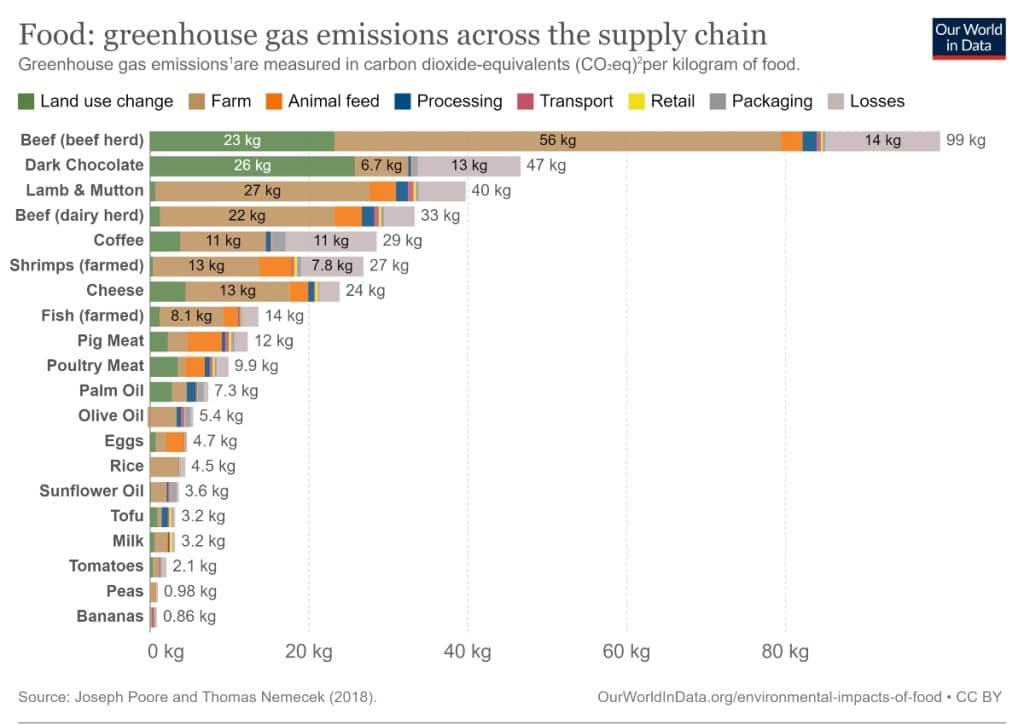
4. Requires Minimal Space
When growing mushrooms indoors, it’s easy to stack bags, bottles or containers of substrate vertically on shelves, and even if you’re growing mushrooms outdoors on logs, you can stack them.
The mushroom council’s sustainability study found that Agricarus bisporus farmers produced an average of 7 lb (3.2kg) per square foot (0.09 square meters) per year.
We have much higher yields than this on our oyster mushroom farm, and produce around 25 lb (11 kg) per square foot per year.
This difference is partly because oyster mushrooms have higher yields than button mushrooms, but they may also have measured the space differently.
If we look at our figures in square meters, on average, we get yields of 100 to 125 kg (220 to 275 lb) of mushrooms per square meter (10.76 square feet) per year.
The graph below from our world in data shows how much land you need in meters squared to produce a kilogram of food.
Mushrooms come in much lower than any food on a graph, and even a low-yielding farm would only need 0.03 square meters of land to produce a kilogram of mushrooms.
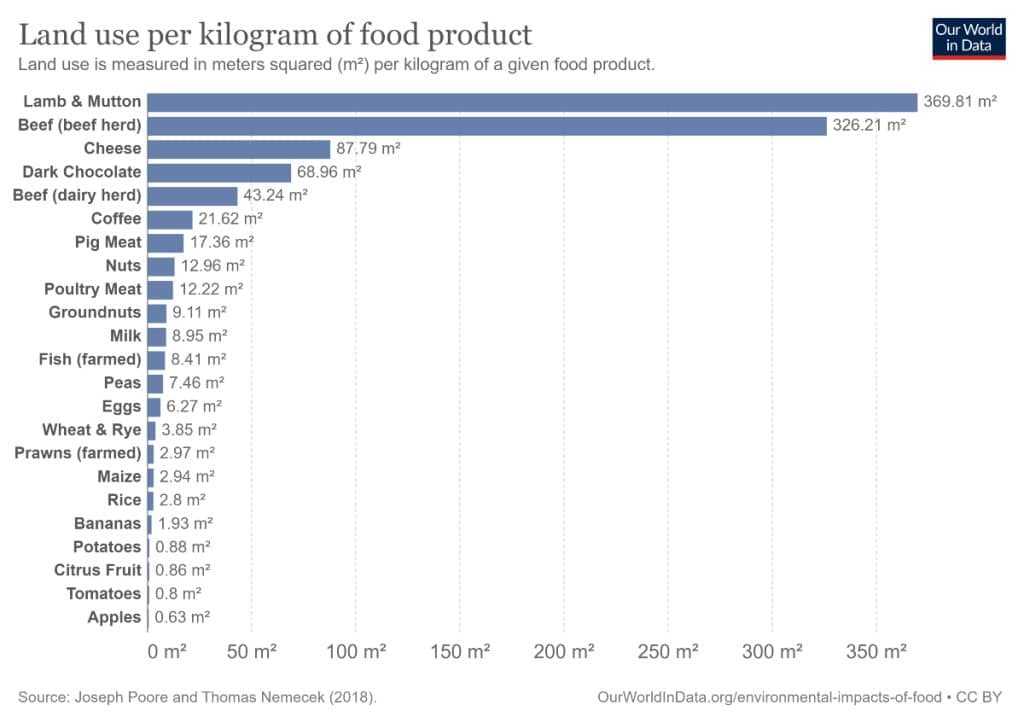
How Much Space Do You Need to Grow Mushrooms?
Aspiring mushroom farmers often wonder how much space they are going to need. The answer varies, and will depend on the type of mushroom, growing methods and quantity you want to produce.
The good news is you don’t need lots of space or equipment to set up a low-tech mushroom farm and get started.
Our advice is to start small, producing less than 44lb (20kg) a week, and when you have all the different phases and processes running smoothly, you can scale up.
If you’re growing oyster mushrooms and produce yields like ours, you’ll need approximately 86 square feet (8 square meters) of space to harvest 44lb (20kg) weekly.
5. Recycles Agricultural Byproducts
Mushrooms grow on dead and decaying organic matter, and most farmers use the byproducts or waste from other agricultural activities for mushroom substrates.
By using agricultural byproducts as substrates, mushroom farmers reduce the amount of waste generated by agriculture and help local ecosystems.
Some of the most commonly used mushroom substrates are hardwood sawdust, soy hulls, oat and wheat straw, manure and used coffee grounds. But there are numerous options available.
We recommend mushroom growers use any uncontaminated organic material they can consistently source locally.

6. Creates Minimal Waste
Most large-scale mushroom producers grow mushrooms in reusable containers, so the only byproduct of mushroom production is spent substrate.
Generally, for every kilogram of mushrooms produced, you’ll have 5 to 6 kilograms of leftover substrate. Fortunately, this substrate is a useful byproduct with several applications and should not go to waste.
Here are some of the ways that you can use spent mushroom substrate:
- As compost for other plants
- For vermicomposting
- As a mulch on lawns and beds
- As a soil amendment to improve soil structure
- As part of potting mixes
- Feed for insects, fish and poultry
- Mixed with other products to produce biogas
- Mixed with other organic matter and used as casing material
Growers who use single-use mushroom grow bags to grow mushrooms produce plastic waste that’s not environmentally friendly, but there are alternatives available.
Later in this article, we look at some ways to reduce plastic waste when growing mushrooms.
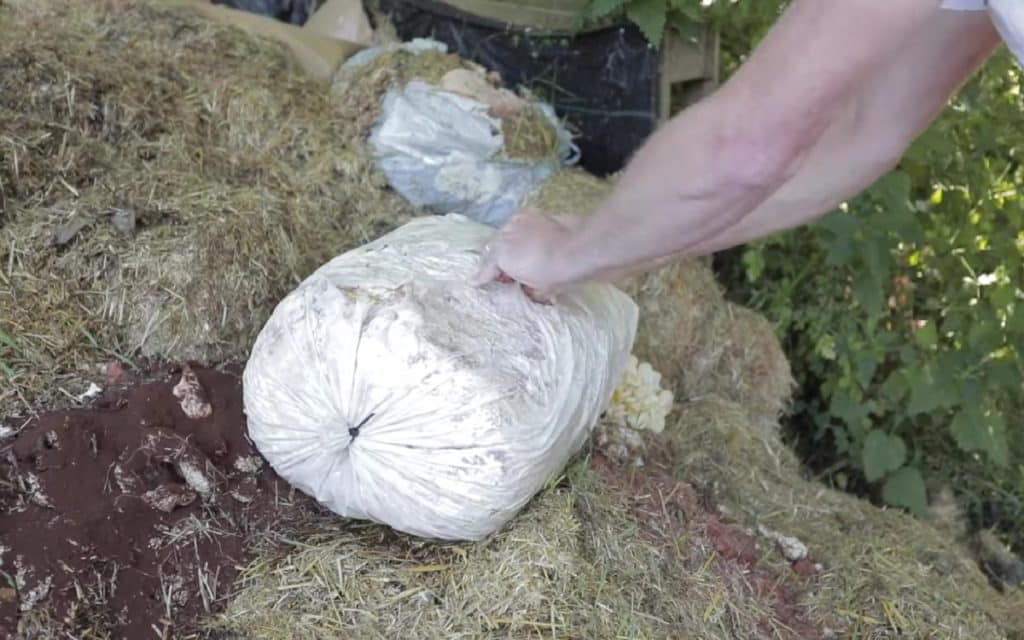
7. Produces Low Resource Protein-Rich Food
Mushrooms are a high-yield, nutrient-dense food source, and most contain high-quality complete proteins with all nine amino acids.
This has made them the focus of several studies exploring their potential as a sustainable source of protein.
Other protein-rich foods, like meat and dairy products, contain more protein than mushrooms but require a lot more resources to produce per kilogram.
For example, it takes 1142.5 gallons (4325 liters) of water to produce 2.2lb (1kg) of chicken, which contains around 310g of protein.
By comparison, it takes 3.9 gallons (15 liters) of water to produce 2.2lb (1kg) of oyster mushrooms that contain around 33g of protein.
You would need 10kg of oyster mushrooms to get a similar amount of protein, but producing 22lb (10kg) of mushrooms would only use 39.6 gallons (150 liters) of water.
This is much less than the 1142.5 gallons (4325 liters) of water required to produce 2.2lb (1kg) of chicken.
This is only considering the water footprint. Mushrooms also use less energy and need less space to produce than other protein-rich foods.
8. Has Lots of Potential Markets
Mushrooms are versatile and have many different uses, giving mushroom farmers plenty of options and potential markets.
Mushroom farmers can sell fresh gourmet mushrooms directly to restaurants or consumers at farmer’s markets. And use less-than-perfect mushrooms to create longer-lasting products like dried mushrooms or mushroom powder, extracts and tinctures.
There’s also a wide range of popular mushroom condiments, including pickled or marinated mushrooms and ketchup. Farmers could produce condiments themselves or sell mushrooms to people who want to make these products.
But fungi are not only a great source of gourmet and medicinal mushrooms. They are also used to produce sustainable building and insulation materials, packaging, textiles and meat replacements.
Because fungi are so versatile, it makes it easier for new mushroom farmers to find a profitable niche in their area.
Alternatives to Single-Use Plastic Bags for Mushroom Farming
Many mushroom farms use autoclavable plastic bags to grow mushrooms because they’re inexpensive and designed to make mushroom growing easier, but they are a problem.
Single-use mushroom growing bags are only used for a short time, are non-biodegradable and are produced using fossil fuels. They make mushroom farming way less eco-friendly.
Fortunately, there are several alternatives for farmers to consider, including growing mushrooms in –
- Mushroom beds using wood, plastic or metal trays. Button mushrooms are often grown this way, but it doesn’t work as well for many other species.
- Reusable, autoclavable plastic bottles. This method is often used in large-scale farms where the entire process is highly automated.
- Plastic buckets. Ideal for small-scale mushroom farmers who want to reduce the amount of plastic waste they create.
- Monotubs made from plastic totes. These are perfect for new or small-scale mushroom growers.
- Compostable mushroom bags. If you are growing mushrooms the low-tech way using cold water pasteurization techniques, 100% biodegradable bags made from starch, cellulose and vegetable oil are a great option.
Final Thoughts
Mushrooms are one of the most sustainable crops to grow, and many consider them functional foods as they provide so many health benefits.
There are several great reasons to start a mushroom farm. And you don’t need lots of money, equipment or space.
To learn how to set up a low-tech mushroom farm, download our free ebook and video, or try one of our mushroom cultivation courses.
